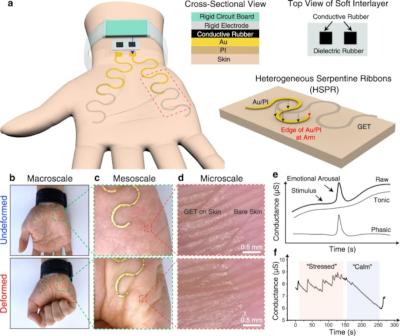Researchers at The University of Texas at Austin and Texas A&M University have used electronic tattoo (e-tattoo) technology to measure stress levels, by attaching a device to people's palms (AKA electrodermal activity or EDA sensing). The researchers created a graphene-based e-tattoo that attaches to the palm, is nearly invisible and connects to a smart watch.
In June 2022, researchers from the same universities also developed a graphene-based electronic tattoo that can be worn on the wrist for hours and deliver continuous blood pressure measurements at an accuracy level exceeding nearly all available options on the market today.
"It's so unobstructive that people sometimes forget they had them on, and it also reduces the social stigma of wearing these devices in such prominent places on the body," said Nanshu Lu, professor in the Department of Aerospace Engineering and Engineering Mechanics and leader of the project.
Lu and her collaborators have been advancing wearable e-tattoo technology for many years. Graphene is seen as a promising material for such applications because of how thin it is and how well it measures electrical potential from human body, leading to very accurate readings. However, such ultra-thin materials can't handle much, if any strain. So that makes applying them to parts of the body that include a lot of movement, such as the palm/wrist, challenging.
The most interesting part of this recent work is how the e-tattoo on the palm is able to successfully transfer data to a rigid circuit - in this case a commercially available smart watch - in out-of-lab, ambulatory settings. The team used a serpentine ribbon that has two layers of graphene and gold partially overlapped. By snaking the ribbon back and forth, it can handle the strain that comes with movements of the hand for everyday activities like holding the steering wheel while driving, opening doors, running etc.
Current palm monitoring tech uses bulky electrodes that fall off and are very visible, or EDA sensors applied to other parts of the body, which gives a less accurate reading.
Other researchers have tried similar methods using nanometer-thick straight-line ribbons to connect the tattoo to a reader, but they couldn't handle the strain of constant movement.
Lu said the researchers were inspired by virtual reality (VR), gaming and the incoming metaverse for this research. VR is used in some cases to treat mental illness; however, the human-aware capability in VR remains lacking in many ways. "You want to know whether people are responding to this treatment," Lu said. "Is it helping them? Right now, that's hard to tell."
